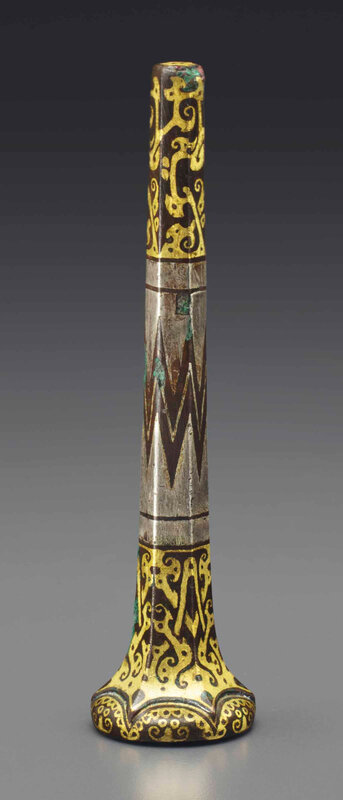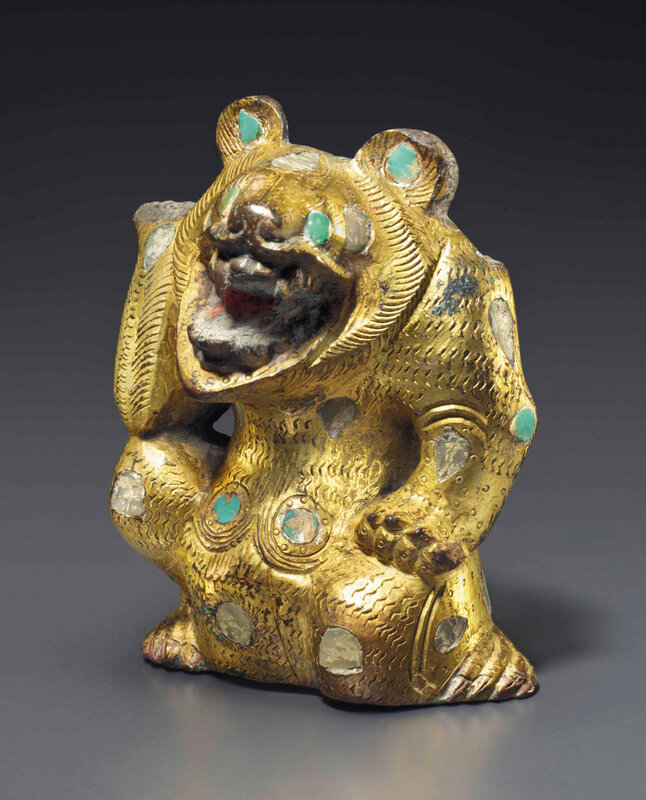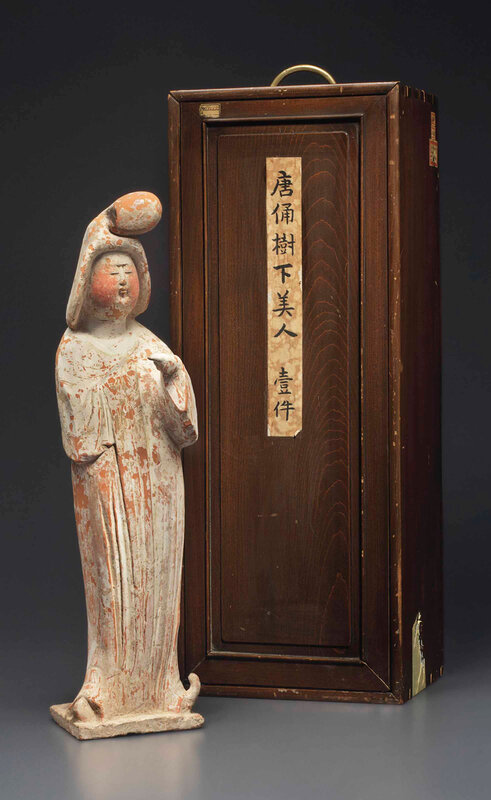The property of a private European collector, by descent from the Reach Family Collection at Christie's NY, 19-20 September 2013
Lot 1498. A gold and turquoise-inlaid bronze garment hook, Late Warring States period, 4th-3rd century BC; 8 in. (20.3 cm.) long. Estimate USD 25,000 - USD 35,000. Price realised USD 37,500. © Christie's Images Ltd 2013.
The slender, arched garment hook is inlaid in gold sheet and wire with a pattern of elongated angular scrolls against a ground of turquoise chips, and the dragon-head hook is encased in gold sheet inlaid with a small tear drop-shaped turquoise chip, , fitted box.
Provenance: Eskenazi, London, 1993.
By descent from the Reach Family Collection.
Note: Compare the similar gold and turquoise inlay on a garment hook illustrated by T. Lawton in the exhibition catalogue, Chinese Art of the Warring States Period: Change and Continuity, 480-222 B.C., Freer Gallery of Art, 1982, p. 100, no. 50.
Lot 1501. A gold and silver-inlaid bronze fitting, Late Warring States period, 4th-3rd century BC; 3½ in. (9 cm.) high. Estimate USD 6,000 - USD 8,000. Price realised USD 22,500. © Christie's Images Ltd 2013.
Of slender, tapering, hexagonal form, the faceted sides are inlaid in silver with a broad central band of chevron pattern between a band of zoomorphic scroll in gold above and interlocking angular scrolls below bordered by a scalloped band enclosing small circles and scrolls. The flat top is inlaid with a tiny gold flower head.
Provenance: Eskenazi, London, no. C695.
By descent from the Reach Family Collection.
Exhibited: Eskenazi, London, Inlaid Bronze and Related Material from pre-Tang China, 11 June - 5 July 1991, no. 18.
Note: A very similar finial was sold at Christie's New York, 2 December 1993, lot 186. See, also, a related finial of this type, illustrated by J. Sewell, Chinese Art from the Collection of James W. and Marilyn Alsdorf, Chicago, 1970, no. B13.
Lot 1503. A rare gold and silver-inlaid bronze fitting, Western Han dynasty, 2nd-1st century BC; 2¼ in. (5.7 cm.) high, 2 in. (5.1 cm.) wide. Estimate USD 15,000 - USD 18,000. Price realised USD 20,000. © Christie's Images Ltd 2013.
Possibly a zither string anchor (se rui), the fitting has a square socket surmounted by a domed cap decorated in the center with a circular platform with central recess above a narrow silver, sawtooth border repeated at the bottom below six pendent petals, separated by tear-shaped recesses, and centered with a recess framed by gold inlay finely incised with a pair of confronted, long-tailed birds standing with wings raised above gold and silver scrolls.
Provenance: Eskenazi, London, no. C2176.
By descent from the Reach Family Collection.
Exhibited: Eskenazi, London, Inlaid Bronze and Related Material from pre-Tang China, 11 June - 5 July 1991, no. 13.
Note: This fitting is similar to others that have been identified as zither string anchors (se rui), such as the example from the Therese and Erwin Harris Collection illustrated by J. So and E. Bunker in Traders and Raiders on China's Northern Frontier, The Arthur M. Sackler Gallery, Smithsonian Institution, Washington DC, 1995, pp. 150-51, no. 72, where the authors discuss the use of these fittings, and how they would have come in sets of four. Such a set of four bronze se rui, of mountain shape, was found in the late second century BC tomb of the King of Nanyue, and is illustrated in Xihan Nanyue Wangmu, vol. II, Beijing, 1991, pl. 48 (1). Several others, of various designs, in the Museum of Far Eastern Antiquities in Stockholm, are illustrated by O. Karlbeck, "Selected Objects from Ancient Shou-chou," BMFEA, vol. 27, Stockholm, 1955, pl. 41 (1-6), including a pair cast with down-turned petals (nos. 5 a&b), which retain traces of string wound around the square socket. Another, excavated at the Han tombs at Mancheng, which is stylistically similar to the present example, is illustrated in Mancheng Han mu fajue baogao, Beijing, 1980, vol. 1, pl. 50 (2).
Lot 1505. A rare gold and silver-inlaid bronze fitting, Western Han dynasty, 2nd-1st century BC; 1¾ in. (4.5 cm.) high, 2 1/8 in. (5.4 cm.) wide. Estimate USD 15,000 - USD 18,000. Price realised USD 18,750. © Christie's Images Ltd 2013.
Possibly a zither string anchor (se rui), the fitting has a square socket with chamfered corners, and is well cast on top in the shape of an open flower with six down-turned petals that are covered in thin gold sheet and that radiate from a medallion cast in high relief in the center as a coiled tiger covered in thin silver sheet.
Provenance: Eskenazi, London, no. C887.
By descent from the Reach Family Collection.
Exhibited: Eskenazi, London, Inlaid Bronze and Related Material from pre-Tang China, 11 June - 5 July 1991, no. 14.
Note: This fitting is similar to others that have been identified as zither string anchors (se rui), such as the example from the Therese and Erwin Harris Collection illustrated by J. So and E. Bunker in Traders and Raiders on China's Northern Frontier, The Arthur M. Sackler Gallery, Smithsonian Institution, Washington DC, 1995, pp. 150-51, no. 72, where the authors discuss the use of these fittings, and how they would have come in sets of four. They note that the early anchors were made of wood, but by the second century BC, were often cast in bronze. A set of four bronze mountain-shaped se rui from the late second century BC tomb of the King of Nanyue is illustrated in Xihan Nanyue Wangmu, vol. II, Beijing, 1991, pl. 48 (1). Several other fittings, of various design, in the Museum of Far Eastern Antiquities in Stockholm, are illustrated by O. Karlbeck, "Selected Objects from Ancient Shou-chou," BMFEA, vol. 27, Stockholm, 1955, pl. 41 (1-6), including a pair cast as a flower with six down-turned petals (nos. 5 a&b), which retain traces of string wound around the socket. Another very similar example is illustrated in Mancheng Han fajue baogao, Beijing, 1980, vol. 1, pl. 50 (3).
Lot 1499. A rare inlay-embellished gilt-bronze bear-form support, Han dynasty (206 BC-AD 220); 3 1/8 in. (8 cm.) high. Estimate USD 30,000 - USD 50,000. Price realised USD 37,500. © Christie's Images Ltd 2013.
The heavy support is hollow cast in the shape of a seated bear with right forepaw raised and left resting on its thigh, and the mouth open. There is a D-shaped opening in the back of the head and a circular opening in the base. The fur is suggested by small linear markings, areas of tiny circles on the sides of the legs, and a textured stripe down the backbone. The eyes, ears and body are embellished with turquoise and jade or glass inlay, and there is some red pigment in the mouth, box.
Provenance: Acquired in Hong Kong, before 2000.
Eskenazi, London, 2001.
By descent from the Reach Family Collection.
Note: Hollow, gilt-bronze bear-form fittings of this type are thought to have held the wood or lacquer legs of vessels or furniture. A pair of fittings of this type are illustrated by d'Argencé in Chinese Treasures from the Avery Brundage Collection, The Asia Society, New York, 1968, pp. 44-5, no. 30.
Lot 1506. A painted red pottery figure of a standing court lady,Tang dynasty (AD 618-907); 17 7/8 in. (45.5 cm.) high. Estimate USD 15,000 - USD 18,000. Price realised USD 18,750. © Christie's Images Ltd 2013.
Shown standing on a rectangular base, the court lady wears long robes that fall in vertical folds to the upturned tips of her shoes, and a long shawl draped over her shoulders and her right hand which she clasps to her breast as she look towards the extended finger of her left hand where a bird may have been perched. Her hair is dressed in a hood-like coif pulled up into a broad loop in front. There is extensive white pigment remaining, and the full face has some bright reddish-pink pigment, fitted wood box.
Provenance: H. Packard, Tokyo.
N.V. Hammer, New York.
Eskenazi, London, 1974, A375.
By descent from the Reach Family Collection.
Exhibited: Eskenazi, London, Early Chinese Ceramics and Works of Art, 1974, no. 21.
Eskenazi, London, Chinese Art from the Reach Family Collection, 1989, no. 10.
Note: Compare to an almost identical pottery figure of a court lady, also dating to the Tang dynasty, and formerly in the Mr. and Mrs. Ezekiel Schloss Collection, New York, illustrated in Ancient Chinese Bronze Vessels, Gilt Bronzes and Early Ceramics, Eskenazi Ltd., London, 1973, p. 74. Like the present figure, the Eskenazi example stands in a similar pose with her hand held aloft and her fingers extended where a bird might have once perched.
Lot 1508. A Qingbai carved deep conical dish, Southern Song dynasty, 13th century; 7¾ in. (19.7 cm.) diam. Estimate USD 6,000 - USD 8,000. Price realised USD 11,875. © Christie's Images Ltd 2013.
The interior is fluidly carved with a large peony spray below the six lobes of the notched rim, and the bowl is covered overall with a crackled glaze of aquamarine color that also surrounds the unglazed center of the base, which has burnt pale brown in the firing.
Provenance: Eskenazi, London, no. A377.
By descent from the Reach Family Collection.
Exhibited: Eskenazi, London, Chinese Art from the Reach Family Collection, 8-22 December 1989, no. 28.
Lot 1507. A rare Qingbai shallow dish, Southern Song-Yuan dynasty, 13th-14th century; 5 3/8 in. (13.8 cm.) diam. Estimate USD 7,000 - USD 9,000. Price realised USD 11,875. © Christie's Images Ltd 2013.
The very shallow sides are impressed on the interior with narrow petals below the flared, petal-lobed rim, and the dish is covered with a pale aquamarine-colored glaze that falls to the edge of the unglazed, flat base.
Provenance: Eskenazi, London, no. A376.
By descent from the Reach Family Collection.
Exhibited: Eskenazi, London, Chinese Art from the Reach Family Collection, 8-22 December 1989, no. 27.
Christie's. Fine Chinese Ceramics & Works of Art, New York, 19 - 20 September 2013

/https%3A%2F%2Fprofilepics.canalblog.com%2Fprofilepics%2F1%2F0%2F100183.jpg)
/https%3A%2F%2Fstorage.canalblog.com%2F03%2F02%2F119589%2F96711876_o.jpg)
/https%3A%2F%2Fstorage.canalblog.com%2F11%2F31%2F119589%2F94773502_o.jpg)
/https%3A%2F%2Fstorage.canalblog.com%2F20%2F83%2F119589%2F94772815_o.jpg)
/https%3A%2F%2Fstorage.canalblog.com%2F26%2F72%2F119589%2F75604929_o.jpg)
/https%3A%2F%2Fstorage.canalblog.com%2F59%2F60%2F119589%2F26458628_o.jpg)










/http%3A%2F%2Fstorage.canalblog.com%2F06%2F32%2F119589%2F129450419_o.jpg)
/http%3A%2F%2Fstorage.canalblog.com%2F86%2F84%2F119589%2F126371203_o.jpg)
/http%3A%2F%2Fstorage.canalblog.com%2F99%2F44%2F119589%2F125979591_o.jpg)
/http%3A%2F%2Fstorage.canalblog.com%2F79%2F79%2F119589%2F120309796_o.png)